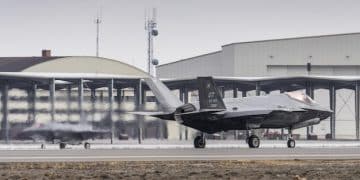US Defense Spending 2025: Impact on Contractors

The projected 7% increase in US defense spending for 2025 is poised to significantly impact defense contractors, potentially leading to increased contract opportunities, heightened competition, and accelerated innovation across various sectors.
The landscape of the US defense industry is on the cusp of a significant shift. With a projected 7% increase in defense spending for 2025, the implications for US contractors are profound, signaling a period of potential expansion, intensified competition, and renewed strategic focus. Understanding these dynamics is crucial for any entity operating within this vital sector.
Understanding the Context of the 7% Increase
The proposed 7% increase in US defense spending for 2025 is not an isolated event but rather a response to a complex global security environment. Geopolitical tensions, technological advancements by peer competitors, and the ongoing need to modernize military capabilities all contribute to this budgetary push. This increase reflects a strategic imperative to maintain a qualitative and quantitative edge, ensuring national security interests are met in an increasingly volatile world.
Drivers of Defense Expenditure Growth
Several key factors are propelling this uplift in defense expenditure. These include a global arms race, particularly in advanced technologies, the need to replenish stockpiles depleted by ongoing conflicts, and a renewed focus on strategic deterrence. The budget aims to address immediate operational needs while simultaneously investing in future defense capabilities, signaling a nuanced approach to national security.
- Global geopolitical instability and conflicts necessitating increased readiness.
- Accelerated technological competition with adversaries, requiring advanced research and development.
- Domestic focus on strengthening the industrial base and job creation.
- Modernization efforts for aging military platforms and systems.
This substantial increase indicates a commitment to robust defense posture. It underscores the government’s recognition of a dynamic threat landscape, one that demands continuous investment and adaptation. For contractors, this translates directly into a broader scope of opportunities and responsibilities within the defense ecosystem.
Direct Impact on Contract Opportunities and Revenue
A 7% increase in the defense budget directly translates into a larger pool of funds available for procurement, research and development (R&D), and sustainment activities. This growth is expected to generate a surge in contract opportunities across a wide spectrum of defense-related sectors. From aerospace and cybersecurity to shipbuilding and advanced materials, contractors can anticipate an uptick in solicitations and awards.
The immediate effect will likely be an expansion of existing contracts and the initiation of new programs. Companies with proven track records and established relationships within the Department of Defense (DoD) may find themselves in a favorable position to secure larger, more lucrative agreements. However, this growth also means that even smaller, niche firms could see increased demand for their specialized technologies and services, provided they align with strategic priorities. Expect to see heightened competition for these new funds.
Key Areas of Increased Spending
The allocation of these increased funds will likely prioritize areas critical to national security and technological advantage. This includes investment in next-generation weaponry, cyberwarfare capabilities, space-based assets, and artificial intelligence. Contractors specializing in these domains are particularly well-positioned to benefit from the budgetary expansion.
- Advanced Weapon Systems: Development and production of hypersonic missiles, stealth aircraft, and precision-guided munitions.
- Cybersecurity and Information Warfare: Enhancing defensive and offensive cyber capabilities, protecting critical infrastructure.
- Space Systems: Investment in satellite constellations for surveillance, communication, and navigation.
- Artificial Intelligence and Machine Learning: Integrating AI across defense applications for enhanced decision-making and operational efficiency.
This strategic allocation intends to close capability gaps and ensure the US military maintains its technological superiority. Companies that can demonstrate innovation, efficiency, and a deep understanding of these priority areas will find themselves highly sought after. The potential for revenue growth for contractors capable of delivering cutting-edge solutions is substantial.
The Rise of Competition and Consolidation
While increased spending brings opportunities, it also intensifies competition among contractors. A larger pie means more players will vie for a slice, potentially leading to more aggressive bidding strategies and a renewed focus on differentiating services and products. Firms will need to showcase not just capability, but also cost-effectiveness and rapid innovation to stand out.
This heightened competitive environment could spur further consolidation within the defense industry. Larger primes might acquire smaller, innovative companies to gain access to their specialized technologies or expand their market share. Conversely, smaller firms might seek strategic partnerships to bolster their capacity and compete more effectively against established giants. The drive for efficiency and scale in response to increased demand could reshape the corporate landscape of the defense sector.
Strategies for Navigating Increased Competition
Successfully navigating this competitive landscape requires a multi-faceted approach. Contractors will need to invest in R&D, streamline their supply chains, and foster a culture of innovation. Building strong relationships with government agencies and understanding evolving procurement processes will also be critical.
- Investing in proprietary technology and intellectual property.
- Developing agile and resilient supply chains to meet demand fluctuations.
- Prioritizing talent acquisition and retention, especially in specialized fields.
- Engaging proactively with government stakeholders and understanding strategic priorities.
Ultimately, the competitive intensity will force contractors to critically evaluate their operational efficiencies and strategic advantages. Those that can adapt quickly, demonstrate superior performance, and offer innovative solutions will be best positioned for success in this expanded market.
Innovation and Technological Advancement
A significant portion of the increased defense budget is earmarked for research, development, test, and evaluation (RDT&E). This focus on R&D is a clear signal that the DoD prioritizes technological superiority and seeks to leverage cutting-edge innovations to address future threats. For defense contractors, this presents an unprecedented opportunity to push the boundaries of what’s possible, driving advancements in various scientific and engineering disciplines.
The emphasis will be on technologies that offer disruptive capabilities, ranging from advanced materials and quantum computing to hypersonics and next-generation AI. Contractors engaged in basic and applied research, as well as those capable of rapidly transitioning prototypes into deployable systems, will be key beneficiaries. This environment fosters deeper collaboration between government, academia, and industry, creating an ecosystem ripe for groundbreaking discoveries and applications.

Emerging Technologies and Their Applications
The investment in R&D is broad, targeting a range of technologies that will redefine future warfare. This includes not just offensive capabilities but also advanced defensive systems, resilient networks, and improved logistical support tools.
- Quantum Technologies: For secure communication, advanced sensing, and computing crucial for signal intelligence.
- Directed Energy Weapons: Development of laser and microwave systems for missile defense and precise targeting.
- Biotechnology and Human Performance: Enhancing soldier capabilities and developing countermeasures against biological threats.
- Additive Manufacturing: For rapid prototyping, on-demand parts production, and localized manufacturing for forward deployment.
The push for innovation is not merely about creating new weapons but also about developing more efficient, sustainable, and adaptable solutions. Contractors that can align their R&D efforts with these strategic priorities will not only secure funding but also position themselves as leaders in the evolving defense technology landscape. This necessitates a strong emphasis on talent acquisition, fostering an innovative corporate culture, and investing in state-of-the-art facilities.
Supply Chain Implications and Workforce Development
The projected increase in defense spending will inevitably place significant pressure on the existing defense supply chain. Contractors will need to ensure their suppliers can scale up production to meet increased demand, which could expose existing vulnerabilities or bottlenecks. Strengthening the domestic supply chain, reducing reliance on foreign components, and diversifying supplier networks will become critical imperatives.
This situation could also stimulate investment in modern manufacturing techniques, such as advanced automation and digital twinning, to enhance efficiency and resilience. Furthermore, the burgeoning demand for specialized skills will exacerbate existing workforce shortages in STEM fields. Contractors will face intense competition for engineers, cybersecurity experts, data scientists, and skilled tradespeople.
Addressing Supply Chain Resilience and Workforce Gaps
To mitigate these challenges, contractors will need proactive strategies. This includes early engagement with suppliers, exploring reshoring initiatives, and investing in workforce development programs. Partnerships with educational institutions and vocational training centers will be vital in cultivating the next generation of defense industry professionals.
- Supply Chain Mapping: Identifying critical components and potential single points of failure.
- Reshoring Initiatives: Incentivizing domestic production of key materials and components.
- Apprenticeship Programs: Developing internal or external programs to train skilled workers.
- University Partnerships: Collaborating with academia to foster research and develop talent pipelines.
The ability to maintain a robust and responsive supply chain, coupled with a highly skilled and adaptable workforce, will be a significant competitive advantage. Companies that invest foresightedly in these areas will be better positioned to capitalize on the increased defense spending and deliver on their commitments.
Regulatory Landscape and Compliance Challenges
With increased defense spending comes heightened scrutiny and a more complex regulatory environment. The US government will undoubtedly seek to ensure accountability, transparency, and efficiency in the allocation and utilization of these substantial funds. Contractors can anticipate more rigorous oversight, stricter compliance requirements, and potentially new regulations aimed at preventing waste, fraud, and abuse.
Navigating this regulatory landscape will require robust internal controls, comprehensive compliance programs, and a deep understanding of federal acquisition regulations (FAR) and other relevant policies. Small and medium-sized enterprises (SMEs) might find these compliance burdens particularly challenging, necessitating investments in legal and compliance expertise. The emphasis on cybersecurity will also extend to the compliance domain, with stricter requirements for safeguarding sensitive information and preventing breaches.

Key Compliance Areas to Monitor
Contractors must remain vigilant and proactive in addressing evolving compliance requirements. This includes not just financial oversight but also ethical conduct, data security, and environmental regulations. Non-compliance can result in severe penalties, contract forfeiture, and reputational damage.
- Cybersecurity Maturity Model Certification (CMMC): Ensuring compliance with new cybersecurity standards for protecting controlled unclassified information.
- Increased Audit Frequency: Anticipate more frequent and thorough audits by government agencies.
- Enhanced Ethical Standards: Greater emphasis on ethical conduct, anti-corruption measures, and conflict of interest policies.
- Supply Chain Risk Management: New regulations related to vetting suppliers and managing supply chain vulnerabilities.
Ultimately, a strong culture of compliance and ethical behavior is not merely a regulatory necessity but a strategic advantage. Companies that can demonstrate unwavering commitment to these principles will build trust with the DoD and reinforce their position as reliable partners. This operational excellence will be critical in securing and maintaining lucrative contracts in a highly regulated environment.
| Key Area | Brief Description |
|---|---|
| 📊 Increased Opportunities | More contracts across various defense sectors due to budget growth. |
| ⚔️ Heightened Competition | Firms will compete more aggressively for larger contract values. |
| 💡 Innovation Drive | Significant R&D investment in advanced technologies. |
| ⚙️ Supply Chain Pressure | Necessity for robust and resilient supply networks. |
Frequently Asked Questions
Sectors poised for significant benefit include aerospace, cybersecurity, advanced materials, and artificial intelligence, driven by the DoD’s strategic shift toward next-generation capabilities and modernization efforts to counter evolving global threats.
Smaller contractors specializing in innovative technologies or niche services may see increased demand, potentially entering into new partnerships or being subject to acquisition by larger primes seeking their advanced capabilities to meet new budgetary priorities.
Key challenges include heightened competition for contracts, potential strain on the supply chain, a more intense demand for skilled labor, and increased regulatory scrutiny, requiring robust compliance and operational efficiency from all contractors.
Yes, the increase is very likely to stimulate job growth, particularly in highly specialized fields such as engineering, cybersecurity, and advanced manufacturing, as contractors expand their workforces to fulfill new and larger contracts.
To best prepare, contractors should focus on innovation, strengthen their supply chain resilience, invest in workforce development, and ensure rigorous compliance with evolving regulatory requirements, ultimately demonstrating adaptability and cutting-edge solutions.
Conclusion
The projected 7% increase in US defense spending for 2025 represents a landmark moment for defense contractors. It signals a period of substantial growth, driven by an imperative to secure national interests and maintain technological superiority. While opportunities abound, so do challenges, including intensified competition, supply chain pressures, and the need for rigorous compliance. Success will hinge on adaptability, a relentless pursuit of innovation, and strategic investments in both technology and human capital. Contractors that can effectively navigate these complex dynamics will not only thrive but also play a pivotal role in shaping the future of global security.





